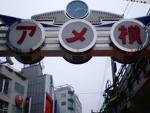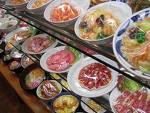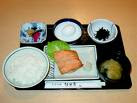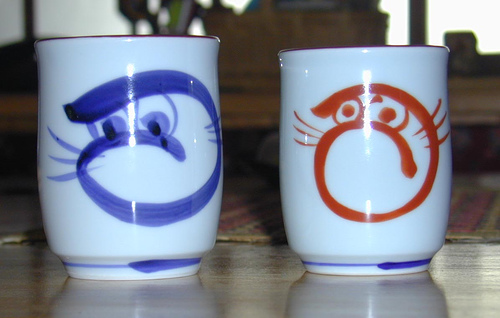::::::::::::::::::::::::::::::::::::::::::::::::::::::::::::::::::::::::::::::::::::::::::::::::::::
Bento
Bento, bentoo 弁当 lunch box, Lunchpaket
ekiben,駅弁 famous lunch boxes at every station, Bahnhofs-Bentō
bentoobako, bentobako, boxes for this lunch 弁当箱
Bentō; O-Bentō, Lunch-Paket
Bentō-Schachtel; Frühstückskasten, Bentoschachtel
gekiyasu bentoo 激安弁当 extremely cheap lunchbox
On July 10, they sold three different types of delicious lunchboxes for 198 YEN in Hyogo prefecture, Kakogawa town, with rice and five pieces of side dishes, for example fried fish or a large croquette.
198円弁当
198円焼きそば弁当 Yakisoba bento
198円カレー弁当 Curry bento
There is a real war out there for cheaper and yet better lunchboxes.
:::::::::::::::::::::::::::::::::::::::::::::::::::::::::::::::::::::::::::::::::::::::::::::::::::::
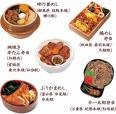
jikiroo じきろう(食籠) food box with a lid
. . . CLICK here for Photos !
. . . hakkaku jikiroo 八角喰籠 (はっかくじきろう) octagonal food box
Those old ones of Negoro laquer are especially famous.
. jikirou 食籠 jikiro - lidded food container .
juubako じゅうばこ (重箱) food box with many layers
. . . CLICK here for Photos !
..... sagejuu さげじゅう(提げ重) box with a handle
koori 行李(こうり) boxes from woven bamboo or willow
They could be thrown away after finishing lunch.
shookado bentoo (松花堂弁当)
A traditional black-lacquered Japanese bento box.
warigo 破り子 cypress containers
since the Heian period, made of thin sheets. Usually with a lid. A kind of magewappa.
Mentsuu めんつう(面桶), menpa めんぱ/ mentsu めんつ
for example
Warigo Soba from Izumo
. . . CLICK here for Photos !
:::::::::::::::::::::::::::::::::::::::::::::::::::::::::::::::::::::::::::::::::::::::::::::::::::
Selling BENTO at the station
aisai bentoo 愛妻弁当
"lunch prepared by a loving wife"
Prepared by the housewife for her family early in the morning. Most condiments are sold as frozen food to make things easier nowadays.
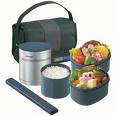
Many workers carry a kind of thermo with three layers for rice, sice dishes and a container for miso soup, whith all food kept warm until the lunchbreak.
. . . CLICK here for Photos !
::::::::::::::::::::::::::::::::::::::::::::::::::::::::::::::::::::::::::::::::::::::::::::::::::::

Bentoobako ― Lunchboxes with Daruma
bentoobako 弁当箱 Bentobako
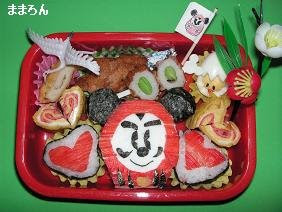

cat for lunch
- Shared by Toshiya Miyamoto -
Joys of Japan, 2012
::::::::::::::::::::::::::::::::::::::::::::::::::::::::::::::::::::::::::::::::::::::::::::::::::::
Issunbooshi bentoo 一寸法師弁当
Issun-Boshi Bento for Tom Thumb
From the Gion Quarter of Kyoto. Yuba tofu skin, Nanbanzuke pickles, kuruma ebi shrimps, local chicken.
Kyoto Obanzai おばんざい vegetables and food from Kyoto

Däumling-Bento
Issunboshi ... The Legend of Tom Thumb
:::::::::::::::::::::::::::::::::::::::::::::::::::::::::::::::::::::::::::::::::::::::::::::::::::
Rokuben, Bento for a kabuki performance in Oshika Village, Nagano
ろくべん, 大鹿歌舞伎
Prepared since the Edo period to be enjoyed whilst watching the village kabuki. Each household prepares its own in laquer boxes with the family crest, so when they share some boxes it will always come back to its owner.
Salted squid, chikuwa, green beans (ingen), pumpkin and other seasonal vegetables, altogether six (roku) items, hence the name. Mixed Rice (mazegohan) was added in one layer of the box.
Since the village is sourrounded by high mountains, it was impossible to get fresh fish.

. . . CLICK here for more kabuki Photos !
::::::::::::::::::::::::::::::::::::::
warigo bentoo わりご弁当 bento for the village kabuki
土庄町の肥土山地区、中山地区で農村歌舞伎
Kabuki-Bentoo from the Island Shodoshima
WARIGO is the name for the wooden box of each family.
. . . CLICK here for Photos !
A performance each year at the shrine Hachiman Jinja was the stage for a village kabuki. Sometimes more than 250 meals were prepared for the village and the actors.
Rice was cooked, as sushi or Inarizushi.
Cooked food was konnyaku, lotus, chikuwa, carrots, goboo, konbu and dried radish.

WASHOKU
Dishes from Shoodoshima 小豆島
:::::::::::::::::::::::::::::::::::::::::::::::::::::::::::::::::::::::::::::::::::::::::::::::::::
chuuka bentoo 中華弁当 with Chinese food.
.......................................................................
hinomaru bento 日の丸弁当
"bento like the Japanese flag"
only white rice and a red pickled plum (umeboshi) in the center.
. . . CLICK here for Photos !
. hinomaru, hi no maru 日の丸 the Japanese Flag .
and
The Good Luck Flag, known as
hinomaru yosegaki (日の丸寄せ書き)
.......................................................................
makunouchi bentoo 幕の内弁当 "eaten between the curtsins" during a Kabuki performance in Old Edo.
with a slice of salmon, an eggroll, pickled plums and other traditional fair.
. . . CLICK here for Photos ! It will make your mouth water !
noriben 海苔弁 slices of nori dipped in soy sauce cover the cooked rice.
A very simple form for busy mothers.
..........................................................................
shidashi-ya しだしや【仕出し屋】catering
Restaurant, das Essen auf Bestellung liefert.

The Shidashiya of Kyoto are especially famous.
They cater for private events and also deliver to temples and tea masters. Many prepare most of the food in their own kitchen and then go to the temple kitchen to prepare a hot soup or cook rice ready eat at the tea ceremony right to the minute. Many have a long tradition with their customers and wooden boards with the names of their client temples, for example, hang at their entrance. They often have long discussions with a priest or tea master about the food, which must be seasonal and beautifully arranged on special dishes.
shidashi bentoo 仕出し弁当 made in a restaurant and delivered for lunch at special occasions, like a funeral or meeting.
similar to
demae 出前 ordering food from a restaurant

okamochi 岡持ち special box for delivering food
food delivery case
usually with a lid or doors a the side and various shelves to store the food.
oka means "hill", maybe a distortion of oke 桶 bucket. Or the food is heaped like a mountain "oka" inside.
岡持にうごくもしれぬ海鼡哉
okamochi ni ugoku mo shirenu namako kana
in the delivery box
it is maybe still moving
this sea slug . . .
Tr. Gabi Greve
Tagaya Kioo 多賀谷亀翁 Tagaya Kio
Haikai poet of the middle Edo period.

okamochi from the Edo period
- - reference - -
. Okamochi for delivering sushi .
sushiuri, sushi-uri 鮨売り / すし売り Sushi vendor in Edo
..........................................................................
Shookadoo Bentoo 松花堂弁当 Shokado Bento Kyoto Kaiseki
sushizume 鮨詰め round box filled with sushi pieces
tori bentoo, shortend to TORIBEN 鳥弁当 with slices of grilled chicken
. . . CLICK here for Photos !
speciality of Gunma prefecture
:::::::::::::::::::::::::::::::::::::::::::::::::::::::::::::::::::::::::::::::::::::::::::::::::::
Famous Ekiben Station Lunchboxes
WASHOKU : Ekiben 駅弁 Station Lunch Box
Lunchpaket vom Bahnhof
:::::::::::::::::::::::::::::::::::::::::::::::::::::::::::::::::::::::::::::::::::::::::::::::::::
kuukoo bentoo 空港弁当 lunchbox at an airport
soraben 空弁(そらべん)
Since 2003, even airports serve special bentos for their visitors with local specialities, to be eaten on the spot or taken home as souvenir.
. . . CLICK here for Photos !
Chuubuu Kokusai Kuukoo Central Airport
misokatsu sando みそかつサンド Sandwich with kotelette in miso
. . . CLICK here for Photos !
Haneda Kuukoo 羽田空港 Haneda Airport
michiko no hamayaki sushi みち子の浜焼き鯖寿司 Sushi
with fish from Wakasa Bay
. . . CLICK here for Photos !
::::::::::::::::::::::::::::::::::::::::::::::::::::::::::::::::::::::::::::::::::::::::::::::::::::
quote
Bentō (弁当 or べんとう, Bentō) is a single-portion takeout or home-packed meal common in Japanese cuisine. A traditional bento consists of rice, fish or meat, and one or more pickled or cooked vegetables as a side dish. Containers range from disposable mass produced to hand crafted lacquerware. Although bento is readily available in many places throughout Japan, including convenience stores, bento shops (弁当屋, bentō-ya), train stations, and department stores, it is still common for Japanese homemakers to spend considerable time and energy producing an appealing boxed lunch.
Bento can be very elaborately arranged. Contests are often held where homemakers can compete for the most aesthetically pleasing arrangements. The food is often decorated to look like people, animals, or characters and items such as flowers and plants. This style of elaborate bento is called kyaraben キャラ弁 (kyara : character bento).
History
The origin of bento can be traced back to the late Kamakura Period (1185 to 1333), when cooked and dried rice called hoshi-ii (糒 or 干し飯, literally "dried meal") was developed. Hoshi-ii can be eaten as is, or can be boiled with water to make cooked rice, and is stored in a small bag. In the Azuchi-Momoyama Period (1568 to 1600), wooden lacquered boxes like today's were produced and bento would be eaten during a hanami or a tea party.
In the peaceful and prosperous time of the Edo Period (1603 to 1867), bento culture spread and became more refined. Travelers and sightseers would carry a simple koshibentō (腰弁当, "waist bento"), consisting of several onigiri wrapped with bamboo leaves or in a woven bamboo box. One of the most popular styles of bento, called makuno-uchi bentō ("between-act bento"), was first made during this period. People who came to see Noh and Kabuki ate specially prepared bento between maku (acts). Numerous cookbooks were published detailing how to cook, how to pack, and what to prepare for occasions like Hanami and Hinamatsuri.
In the Meiji Period (1868 to 1912), the first ekibentō or ekiben (駅弁当 or 駅弁, "train station bento") was sold. There are several records that claim where ekiben was first sold, but it is believed that it was sold on 16 July 1885, at the Utsunomiya train station, and contained two onigiri and a serving of takuan wrapped in bamboo leaves. As early schools did not provide lunch, students and teachers carried bento, as did many employees. A "European" style bento with sandwiches also went on sale during this period.
In the Taishō period (1912 to 1926), the aluminum bento box became a luxury item because of its ease of cleaning and its silver-like appearance. Also, a move to abolish the practice of bento in school became a social issue. Disparities in wealth spread during this period, following an export boom during World War I and subsequent crop failures in the Tohoku region. A bento too often reflected a student's wealth, and many wondered if this had an unfavorable influence on children both physically, from lack of adequate diet, and psychologically, from a clumsily made bento or the richness of food. After World War II, the practice of bringing bento to school gradually declined and was replaced by uniform food provided for all students and teachers.
Bento regained its popularity in the 1980s, with the help of the microwave oven and the proliferation of convenience stores. In addition, the expensive wood and metal boxes have been replaced at most bento shops with inexpensive, disposable polystyrene boxes. However, even handmade bento have made a comeback, and they are once again a common, although not universal, sight at Japanese schools. The Bento is still used by workers as a packed lunch, by families on day trips, for school picnics and sports days etc. The Bento, made at home, is wrapped in a furoshiki cloth, which acts as both bag and table mat.
In 2003, airports started offering an analogous version of the ekiben: bento filled with local cuisine, to be eaten while waiting for an airplane or during the flight.
© More in the WIKIPEDIA !
*****************************
Worldwide use
*****************************
Things found on the way
*****************************
HAIKU
駅弁に掌のひら程の鮭がつき
ekiben ni te no hira no shake ga tsuki
station lunchbox ...
a piece of salmon
the size of my hand
Hoshi Reiko 星令子
:::::::::::::::::::::::::::::::::::::::::::::::::::::::::::::::::::::::::::::::::::::::::::::::::::
駅弁に鮭のフライも郷土色
ekiben ni shake no furai mo kyoodo iro
the fried salmon
of this station lunch box also
has the color of home
Shunsui 春翠
*****************************
Related words
***** WASHOKU : Regional Japanese Dishes
***** Sansai 山菜 Mountain vegetables
***** WASHOKU : General Information and References
bentoo, bentou, bentoh, Deutschland
:::::::::::::::::::::::::::::::::::::::::::::::::::::::::::::::::::::::::::::::::::::::::::::::::::
